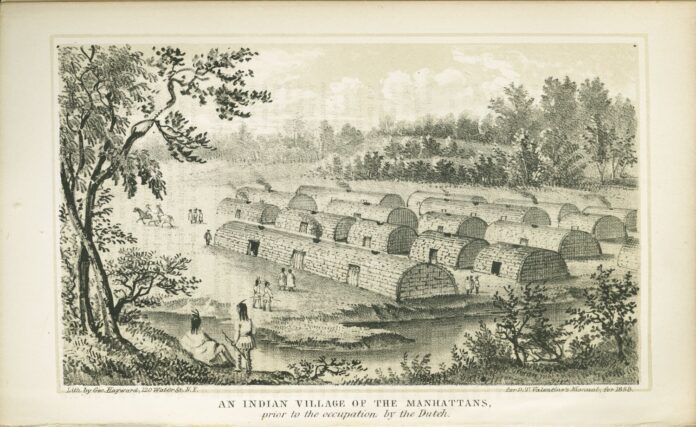These achievements were certainly worthy of recognition, but the narratives generally did not address the impact of the European settlements on the indigenous population. According to historians William Burrows and Mike Wallace “By the time Europeans appeared on the scene . . .what is now New York City had as many as fifteen thousand inhabitants—estimates vary widely—with perhaps another thirty to fifty thousand in the adjacent parts of New Jersey, Connecticut, Westchester County, and Long Island.” The inhabitants of this region were the Lenape, also known as the Lenni Lenape, or Munsee, and later as the Delaware. (Gotham, 1993.)
Today, anniversary organizers are endeavoring to weave the experience of indigenous peoples into programs and events. The lack of traditional documentary evidence makes this worthy effort a challenge. Eric W. Sanderson, author of Mannahatta: A Natural History of New York City, summarized the problem: “Much of what we can say about the Lenape on Manhattan comes from a composite of archeological evidence, historical anecdotes, folk etymologies, interview with modern Lenape, and inference from other places. Which is to say, what we know for certain is really very little.”
The Municipal Archives’ Old Town, New Amsterdam and Common Council collections comprise some of these relatively few sources of information documenting the indigenous population of what would become New York City. It is important to note that these records, all created by the colonists, are inherently biased. Imperfect as they may be, however, they do provide some useful data and will continue to inform scholarship.
For the Record previously highlighted the Old Town collection and references to indigenous peoples, in Indexing the Dutch Records of Kings County. This week’s article looks at the New Amsterdam and Common Council collection. The records for the time period 1647-1831 have been transcribed, printed, and indexed. Scanning the indexes reveals the mostly negative nature of interactions between the colonists and the indigenous peoples. Citations under the index term “Indians” from the Dutch era include: “inquiry into the massacre by; property lost in troubles with; fine for lodging; etc. For the English-colonial period, after 1664, there are citations such as “selling liquors to, prohibited; trading with, without license prohibited; penalty for harboring,” and so on.
Turning to the first relevant entry in the English-translated version of the New Amsterdam records dates from July 1, 1647. It addresses what seems to have been a recurring theme in legislative action regarding indigenous peoples: regulating liquor.

